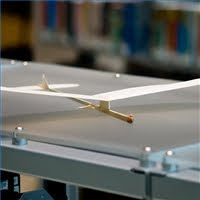 Few experiences are as satisfying as watching a model airplane you have built soar through the summer sky. A balsa wood glider is easy to build and serves as the perfect primer to flying model airplanes, introducing the builder to building techniques, aerodynamics and flight trimming. Be prepared to spend a few sessions building your model. Each step is fairly simple, but thorough sanding and careful gluing will pay off when your bird takes wing.
Few experiences are as satisfying as watching a model airplane you have built soar through the summer sky. A balsa wood glider is easy to build and serves as the perfect primer to flying model airplanes, introducing the builder to building techniques, aerodynamics and flight trimming. Be prepared to spend a few sessions building your model. Each step is fairly simple, but thorough sanding and careful gluing will pay off when your bird takes wing.Things You'll Need:
* Plans: See the resources for a good first model
* A 1/16" sheet of balsa wood
* A 1/32" sheet of balsa wood (1/16" balsa can be sanded down to 1/32")
* A 1/8" sheet of balsa wood (2 1/16" pieces can be glued together)
* Some plans may also call for spruce. You can use basswood if spruce is unavailable.
* Modeling knife
* Wood Glue
* Several grades of sandpaper (100-320 grits)
* A sanding block
* Modeling clay for nose weight
Building the Model
1. Print the plans to scale.
2. Mark the outline plans on the balsa wood. To transfer the outlines of the plan to the wood cut the outline out and trace around it, or place the plan over the wood and, pressing gently with a ball point pen, follow the outlines. The soft balsa will take the impression of the pen and provide you with a line to cut on. Unless the plan states otherwise the grain of the wood should run along the longest dimension of the piece.
3. Using the modeling knife, cut out the parts from the plan. Work carefully, taking multiple passes. The wood will cut or split easily along the grain and will be much more difficult to cut across the grain.
4. Sand the pieces into their final shape. Because the model is made from solid pieces of wood, rather than from a covered frame, most of the shaping of the structure will come from sanding. Start with the edges but avoid for now edges which will be glued together later (the inner edge of the two wing halves, the bottom of the vertical stabilizer and the places on the fuselage where the wing and horizontal stabilizer will be mounted). You can hold identical pieces, like the two halves of the wing, together as you sand so they maintain an identical shape. Once the edges are sanded, you can turn to the surfaces. Using medium grade sandpaper, sand the fuselage and the tail pieces until they are smooth to the touch.
5. Sand an airfoil into the wing. The airfoil of a wing, along with its angle of attack, is what provides the plane with "lift." The airfoil shape should make the wing rounded along the leading edge, widening toward the center and then tapering almost to a point at the trailing edge.
6. Sand the inner edge of each of the wings to an angle that will create "dihedral" when the two halves are glued together. The amount of dihedral should be marked on the plan and is measured as the distance each wingtip is from where it would be if the wing were perfectly flat. With the wing's leading edge facing away from you, prop up one half of the wing with a small block so the wingtip is at the proper height. Take a sanding block and place it vertically against the inner edge. Sand until the edge is perfectly flat and perpendicular to the work surface. Repeat with the other wing half.
7. Glue the two wing halves together. Using blocks under both wingtips to create the proper dihedral, apply a bead of glue to the inner edge of each of the wing halves. Press the two halves together. Remove the excess glue. Place a light weight on the wing near the center joint to hold it in place. Measure the dihedral again and make any necessary adjustments. Let the glue dry for a couple of hours
8. Assemble the plane. Pay special attention to the angle of the horizontal stabilizer relative to the angle of the wing (this is called wing incidence). Check your parts against the plan to be sure the proper angles are maintained as you build. If the wing incidence is incorrect the model will fly poorly. Let the glue dry for a couple of hours.
Trimming and Flying
9. Balance the plane. Place a finger on the bottom of each wing half, roughly in the middle of the width of the wing. Balanced this way, the plane will tip toward the tail. Add modeling clay for weight on the nose of the plane until you achieve a level balance.
10. Test fly the plane. Holding the plane at shoulder height, with the nose angled slightly downward, gently push the plane as you release it into the air. Don't throw it or toss it. The glider should fly fairly straight on a nice smooth, steady path.
11. Trim for the perfect flight. If the plane dives out of your hand, remove some nose weight. If the plane flies sharply upward then stops (stalls) and flips downward into a dive, add more nose weight. If the plane veers sharply to the right or left, gently bend the back edge of the vertical stabilizer to compensate for the turn until the glider flies fairly straight.
Tidak ada komentar:
Posting Komentar